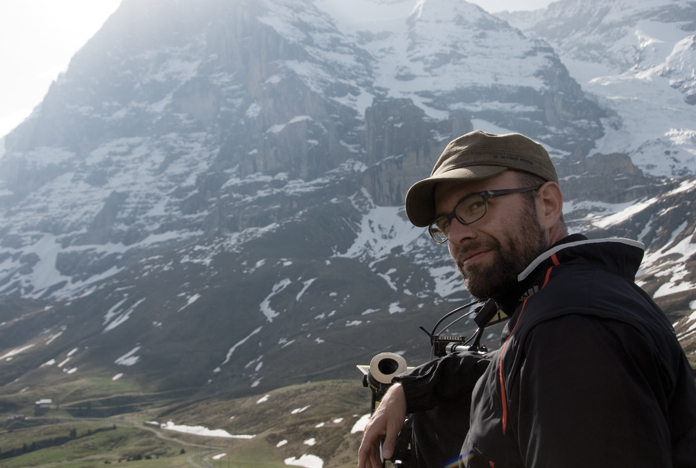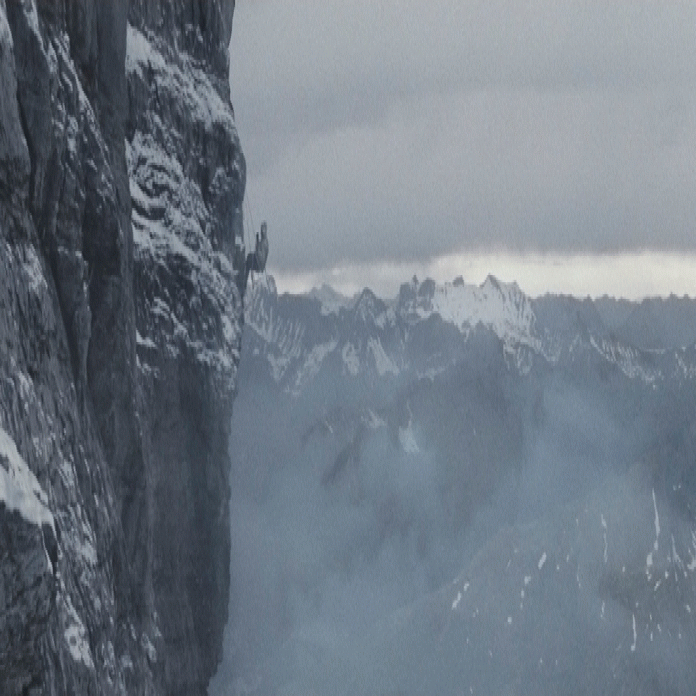
Director Philipp Stölzl
Philipp Stölzl
Interview with the director of North Face
Feb 11, 2010
Philipp Stölzl
![]()
In making North Face (Nordwand), an adventure film about alpinists ascending the most dangerous rock face in the Alps, German writer/director Philipp Stölzl and cinematographer Kolja Brandt disregarded such Hollywood films as Cliffhanger and Vertical Limit and aimed instead for the authenticity of the documentary/reenactment film Touching the Void. Set in 1936, North Face is based on the true story of Toni Kurz (Benno Fürmann) and Andi Hinterstoisser (Florian Lukas), two climbers who attempted to be the first to scale the Eiger, a treacherous mountain in the Swiss Alps, at a time when Nazi propagandists urged German mountaineers to achieve such deadly feats. Stölzl and Brandt shot the film in the Bernese Oberland area of Switzerland, where the Eiger stands, using real-life alpinists as stunt doubles to capture frequently impressive shots of the ascent. The Eiger is distinctive not only for its massive, 1,800-meter-high (5,900 ft.) North Face, but also the Jungfraubahn, a railway that runs through tunnels inside the mountain.
Stölzl previously has directed music videos for performers ranging from Rammstein to Madonna to Luciano Pavarotti, and prior to North Face, he was directing opera. His screenplay for North Face won a German Film Critics Award, and the film earned German Film Academy Awards for Best Sound Design and Brandt’s cinematography. Stölzl discussed North Face with Under the Radar prior to its Los Angeles theatrical opening. The film will play in select cities through the upcoming months.
What was the biggest challenge in writing a screenplay based on true events? How much could you rely on research? For instance, we are given specific dates and times during certain stages of the climb.
The biggest challenge was surely to meld the fictional elements of the screenplay, the love story for example, with the historic facts. It took us quite some time to find the right balance. What we know about the true event is a puzzle of proven information and assumptions. There is quite some stuff people saw through the binoculars from the luxury hotel below the North Face. As long as the weather was clear, they saw when the climbers were at what point, when they gave up and turned, etc. And there is other information Toni Kurz shouted down to the Swiss mountain guides, who were trying to save him, before he died. Also the corpses of the other climbers, who were found later on the wall base, also gave some indication how things went.
I read that your cinematographer Kolja Brandt spent three months training for the shoot. What kinds of preparations were important for you in order to attain the authenticity of the film’s climbing sequences?
Kolja basically started climbing for this movie—and got totally hooked. He is just now on a pretty tough climbing expedition in South America. To get the film authentic, all actors went into climbing training for almost a year and we had a specialist on board that made sure the climbing techniques were historically accurate. Climbing was very different back in the ‘30s, not only in gear and knots, etc., but also in climbing style.
By today’s standards, how safe was the equipment that Kurz and Hinterstoisser used? Would anyone today climb with the same equipment?
Climbing back then definitely required some courage; clothing wasn’t made to resist bad weather, the hemp ropes were super dangerous in case of a fall, the hobnailed boots are difficult to climb with. Stephan Siegrist, a Swiss top mountaineer climbed the Eiger North Face once with the old equipment as an experiment. He says it was a nightmare.

I would imagine that this was a difficult shoot. Of course, you want the shoot to go as smoothly and easily as possible, but in the times when it became physically demanding, did you ever think that the difficulty was appropriate, given what Kurz, Hinterstoisser and their colleagues endured?
We definitely got a sense of how hard it must have been for these boys. We shot a part of the movie in pretty tough snowstorm situations at the Eiger. Another part of it was shot in a minus-15-degrees-Celsius freezer that we used as a studio. Everyone was very happy when that was finally done.
What was it like shooting in the Bernese Oberland area? Were there many structures that still stand as they were in 1936? What about the Jungfraubahn? How much has that changed?
The region was very helpful to us. They supported us with experienced mountain guides and helicopter pilots. The Jungfraubahn hasn’t changed much, just the trains are new and they are totally overcrowded with Japanese tourists these days. Logistically, the train is of great help for the shoot. You can load all your equipment in, stop in the middle of the tunnel inside the mountain, carry your stuff through a drift, open a wooden door, and then you are right in the middle of the North Face!
How do German audiences these days respond to films that are set during the Nazi era? Is there any kind of aversion to them, or does there remain curiosity about that period in history?
The Germans are very used to being faced with this period. There are a lot of movies that are set in this time. This permanent contention with our dark past is a part of our national identity. A good thing, in my opinon.
In making the film, did you discover anything about 1930s Germany that surprised you, either positively or negatively?
How much mountaineering became a part of the Nazi propaganda was surprising for me. I didn’t know it had that scale. Most of the stuff the journalist Arau is talking about is taken from speeches of Nazi sport officials.
What was the most difficult scene for your actors to endure?
The last bivouac before the climbers descend. We shot that in the freezer and made our own snowstorm with wind machines and real snow from snow canons we rented from ski resorts. The actors were literally covered with ice in the shot.
There are times when the sound design of the film is especially important—for example, when the characters’ voices barely can be heard calling out through the storm. How meticulous were you about sound?
It took quite some time to get that right. Fortunately, I had some fantastic sound designers on board. They even won a prize for their work on Nordwand, well earned.
What project are you working on now?
I am just editing my next movie, which I shot last summer. It is a historic movie about legendary German writer Johann Goethe, set in the late 18th century.
Current Issue

Issue #72
Apr 19, 2024 Issue #72 - The ‘90s Issue with The Cardigans and Thurston Moore
Most Recent
- Under the Radar Announces The ’90s Issue with The Cardigans and Thurston Moore on the Covers (News) — The Cardigans, Thurston Moore, Sonic Youth, Garbage, The Cranberries, Pavement, Lisa Loeb, Supergrass, Spiritualized, Lush, Miki Berenyi, Miki Berenyi Trio, Emma Anderson, Hatchie, Ride, Slowdive, Velocity Girl, Penelope Spheeris, Terry Gilliam, Gus Van Sant, Ron Underwood, Kula Shaker, Salad, Foals, Semisonic, The Boo Radleys, Stereo MC’s, Pale Saints, Blonde Redhead, Sleater-Kinney, Cocteau Twins, Lucy Dacus, Alex Lahey, Horsegirl, Grandaddy, alt-J, Squid, The Natvral, Wolf Alice, Jess Williamson, Sunflower Bean, Orville Peck, Joel McHale
- 10 Best Songs of the Week: Fontaines D.C., Cassandra Jenkins, Loma, John Grant, and More (News) — Songs of the Week, Fontaines D.C., Cassandra Jenkins, Loma, John Grant, Good Looks, Hana Vu, Belle and Sebastian, Yannis & The Yaw, Strand of Oaks, Home Counties
- Fresh Shares New EP ‘Merch Girl’ (News) — Fresh
- Premiere: LOVECOLOR Shares New Video for “Crazy Love” (News) — LOVECOLOR
- Final Summer (Review) — Cloud Nothings

Comments
Submit your comment
February 21st 2010
12:14pm
Great to see you had experienced helicopter pilots. Can never be to careful in the mountains.
March 11th 2010
7:54pm
As usual a very interesting interview in which we readers have the opportunity to learn more from the field of film industry.
March 26th 2010
3:54am
I had some fantastic sound designers on board. They even won a prize for their work on Nordwand, well earned.
April 9th 2010
5:36pm
Thanks for sharing. Had a very good article. I thank you again
July 23rd 2010
10:48pm
After specification of the radio network planning for a region to inform the respective mobile operators, the authority concerned on the intention of a planned construction project with a concrete indication of a harmful search area (location area for new transmitters, depending on the surrounding network structure).
January 10th 2011
5:14am
There are only two kinds of mountain climbing movies: The ones where a bunch of people die before the triumphant survivors make it to the summit, and the ones where everybody dies — the end. I won’t tell you which category North Face belongs in, but you can be sure that the German import opening Friday at the Tampa Theatre is a harrowing experience. Directed by music video director Philipp Stölzl, North Face is also a terrific technical achievement that brings to the screen vertiginous sights that had me wondering how no one died during the making of this movie.
“Rolex Submariner”
January 28th 2020
11:26pm
I read your Blog I want to say that I have no idea about this type of information. I want to say that these days I will visit <a >cherry blossom tours</a> after coming back from this trip I will share your information with my friends.
March 7th 2020
12:09am
I read this article and will try to read but this more.